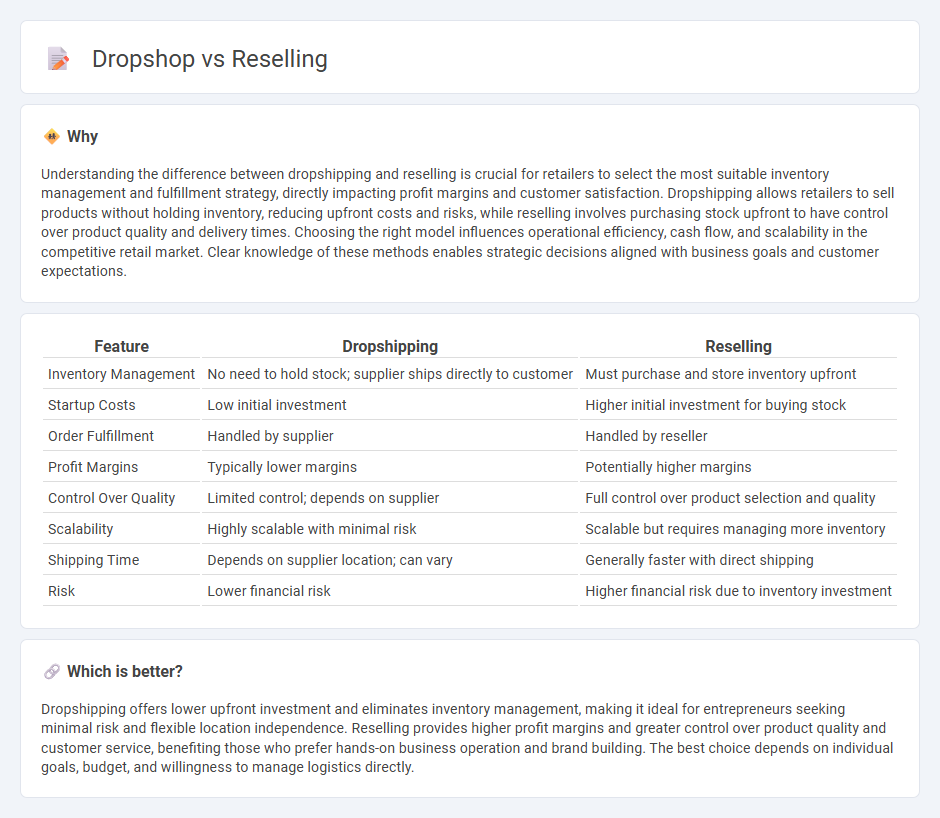
Dropshipping eliminates the need to hold inventory by partnering with suppliers who ship products directly to customers, reducing upfront costs and storage risks. Reselling involves purchasing goods in bulk to sell at a markup, allowing for greater control over pricing and branding but requiring inventory management and upfront investment. Explore the advantages and challenges of each model to determine which suits your retail strategy best.
Why it is important
Understanding the difference between dropshipping and reselling is crucial for retailers to select the most suitable inventory management and fulfillment strategy, directly impacting profit margins and customer satisfaction. Dropshipping allows retailers to sell products without holding inventory, reducing upfront costs and risks, while reselling involves purchasing stock upfront to have control over product quality and delivery times. Choosing the right model influences operational efficiency, cash flow, and scalability in the competitive retail market. Clear knowledge of these methods enables strategic decisions aligned with business goals and customer expectations.
Comparison Table
| Feature | Dropshipping | Reselling |
|---|---|---|
| Inventory Management | No need to hold stock; supplier ships directly to customer | Must purchase and store inventory upfront |
| Startup Costs | Low initial investment | Higher initial investment for buying stock |
| Order Fulfillment | Handled by supplier | Handled by reseller |
| Profit Margins | Typically lower margins | Potentially higher margins |
| Control Over Quality | Limited control; depends on supplier | Full control over product selection and quality |
| Scalability | Highly scalable with minimal risk | Scalable but requires managing more inventory |
| Shipping Time | Depends on supplier location; can vary | Generally faster with direct shipping |
| Risk | Lower financial risk | Higher financial risk due to inventory investment |
Which is better?
Dropshipping offers lower upfront investment and eliminates inventory management, making it ideal for entrepreneurs seeking minimal risk and flexible location independence. Reselling provides higher profit margins and greater control over product quality and customer service, benefiting those who prefer hands-on business operation and brand building. The best choice depends on individual goals, budget, and willingness to manage logistics directly.
Connection
Dropshop and reselling are interconnected through their shared business model of selling products without holding inventory, enabling entrepreneurs to launch retail operations with minimal upfront costs. Dropshop utilizes a digital platform to source and fulfill products directly from suppliers, while resellers leverage this method to market goods to end customers efficiently. Both strategies capitalize on streamlined supply chain management and digital marketing to maximize retail profit margins.
Key Terms
Inventory Ownership
Reselling involves purchasing products upfront and maintaining inventory ownership, which allows full control over stock and potential profit margins. Dropshipping, in contrast, eliminates the need for inventory ownership by directly shipping products from suppliers to customers, reducing overhead costs but limiting control over product availability. Explore the pros and cons of inventory ownership in both models to choose the best fit for your business strategy.
Fulfillment Method
Reselling involves purchasing products upfront and managing inventory, leading to direct control over fulfillment and faster shipping times. Dropshop relies on third-party suppliers to handle storage and shipping, reducing upfront costs but potentially causing longer delivery periods. Discover the detailed pros and cons of each fulfillment method to optimize your e-commerce strategy.
Profit Margins
Reselling typically offers higher profit margins due to bulk purchasing and direct inventory control, while dropshipping provides lower margins but reduces upfront costs and inventory risks. Profitability in reselling can be enhanced through strategic sourcing and negotiated supplier prices, whereas dropshipping relies heavily on pricing strategy and supplier reliability. Explore detailed comparisons to determine which model suits your business goals for maximized profits.
Source and External Links
Reselling in Amazon Stores: Guidelines and Tips for Success - Reselling involves buying products from various sources and selling them directly to customers, with steps including researching demand, sourcing products, listing online, handling fulfillment, and managing inventory and customer service, exemplified by Amazon's platform where independent sellers make significant sales.
Learn How To Become a Reseller And Start Selling Right Away - Reselling is a business model where you purchase goods from manufacturers or others and sell them, often enabling you to avoid sales tax when holding a reseller business permit, while providing customers benefits such as buying items individually and improved shopping experience.
How To Get Started as a Reseller: What and Where To Sell - Reselling means selling products again, often purchasing items to sell at a markup on platforms like eBay or Etsy, with clothing resale growing fast and the business model being accessible for its low overhead and ease of entry.
 dowidth.com
dowidth.com